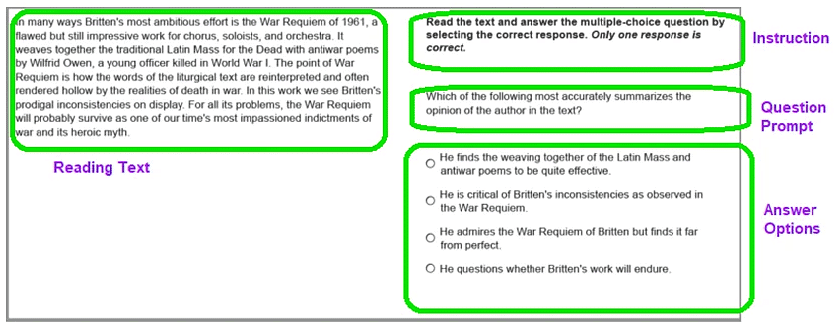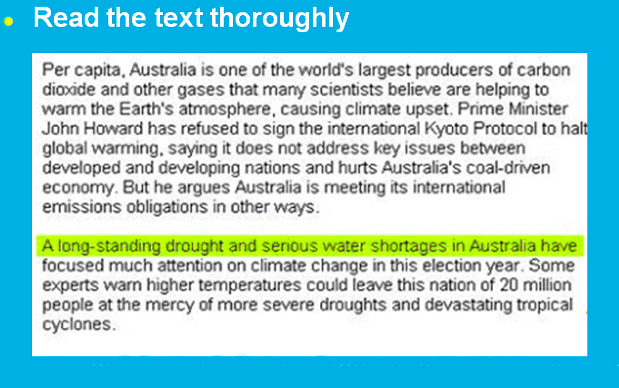Multiple Choice Single Answer - Overview and Tips | Reading Section for PTE PDF Download
PTE Reading Multiple Choice, Choose Single Answer Overview
Now, let me elaborate on how to approach the Multiple Choice, Choose Single Answer task, which constitutes the initial question type in the Reading section. Your first step is to carefully read the text provided. Subsequently, respond to a multiple-choice question regarding the content of the text by selecting the most appropriate answer from the provided options. It's important to note that this task exclusively contributes to your reading score and not to any other sections of the PTE.
You might be curious about the inclusion of this task in the exam. Its primary purpose is to evaluate your reading skills, assessing your ability to analyze, interpret, and evaluate a brief reading passage on an academic subject. Your response is dependent on your accurate reading and analysis of the text. In the exam, only 1-2 questions are presented, and the text's length is approximately 300 words. These texts are intentionally designed to be straightforward and easily comprehensible.
Time Management
When getting ready for the PTE exam, it's crucial to recognize the pivotal role that time plays. Specifically, you should allocate no more than 1 minute and 30 seconds for this task. In this particular section, your response is binary – it is either deemed correct or incorrect. There is no room for partial credit, as you are required to select a single answer from the provided options during the exam.
PTE Reading Multiple Choice, Choose Single Answer Layout
I believe we've covered sufficient discussion for now. Let me proceed to illustrate how the question appears in a real exam.

Here is the format for Multiple Choice, Choose Single Answer. The text you'll read is on the left-hand side, while on the right-hand side, you'll find the task prompt followed by the question prompt. Unlike other tasks, there won't be a specific heading for Multiple Choice, Choose Single Answer. Once you've read the task prompt, you'll understand the nature of the question. As you continue, you'll encounter the options at the end, from which you'll make your selection.
PTE Reading Multiple Choice Choose Single Answer Tips & Tricks
While the question may seem straightforward, it's essential to employ certain techniques and strategies to successfully address it within the allotted time frame.
Tips
Before delving into the passage, take a moment to review the question. This preliminary step ensures that, as you read the provided text, you can focus on the relevant information needed to answer the question accurately, preventing you from overlooking crucial details.
Furthermore, bear in mind that there is only one correct answer, even if some choices may seem plausible. In cases of uncertainty, reevaluate the text to identify the most fitting response.
If you find yourself unsure of the correct answer, initiate the process by eliminating options that are clearly incorrect. By scrutinizing the question and available choices, you should be able to eliminate at least one or more answers, increasing your likelihood of selecting the correct response.
Tricks
Ultimately, ensure that you respond to all the questions. If you encounter a question where you're uncertain about the correct answer, avoid leaving it unanswered. Instead of randomly choosing an option you know is incorrect, eliminate choices that you can confirm are false. While it's possible that you may not arrive at the correct answer, making an attempt increases your chances of obtaining points.
Up to this point, you should have gained an understanding of what Multiple Choice, Choose Single Answer entails. You've seen its format in an actual exam and learned how to approach the question for a suitable response.
Now, let's delve into a strategic approach to enhance your efficiency in preparing for and addressing this type of question. Follow these steps systematically.
PTE Reading Multiple Choice Choose Single Answer Strategy
Step 1- Read the question prompt and identify what is needed

Typically, candidates tend to commence by reading the text, but this approach is misguided and ultimately time-consuming. Rather than diving into the text right away, it's more effective to initiate the process by reviewing the question prompt. This approach provides the necessary focus and helps you identify what information is required for a successful answer. The question might be seeking specific details, the author's opinion, their attitude or feelings, the central idea of the passage, or an inference. Pay careful attention to the inquiry and read with a targeted mindset accordingly.
Step 2- Read answer options and connect to the question

Moving forward, swiftly review the answer choices and aim to establish a connection with the question. In the provided sample question, carefully examine the question and seek its correlation with the available options. Pay attention to the highlighted keywords, as they will guide you to identify something that serves as an 'indicator' of 'climate change in 'Australia.'
Step 3- Read the text thoroughly

Following the examination of the question prompt, you'll progress to this stage, where a careful reading of the text is essential. Adequate preparation for the exam involves extensive reading practice. Consider reading English newspapers to enhance your ability to quickly grasp the main idea from a given passage. If the question pertains to specific details, you must thoroughly read the passage to locate the answer. In the case of other question types, read the entire text before formulating your response. For instance, when tackling 'main idea' questions, comprehend the entire passage to identify its central theme.
Step 4- Eliminate impossible answers in Multiple Choice Choose Single Answer

Now, proceed to the subsequent stage, which involves eliminating improbable answers. This implies that certain answer options provided will lack coherence, so promptly discard them. For instance, following the reading of the aforementioned text, you may deduce that the first option is likely correct. The second option seems implausible. The third option, relating to gas emissions, is unlikely to be correct since it is not an indicator of climate change. Uncertain about the fourth option. The fifth option, however, is highly probable, especially considering recent news coverage.
Step 5- Choose the correct answer

Once you have excluded the implausible answers, you'll be left with one or two shortlisted options, and from these, you must choose the most suitable answer. As observed in the previous step, it appeared that the last option was the most likely answer.
FAQs on Multiple Choice Single Answer - Overview and Tips - Reading Section for PTE
| 1. What is the purpose of the PTE Reading Multiple Choice, Choose Single Answer section? |  |
| 2. How is the layout of the PTE Reading Multiple Choice, Choose Single Answer section structured? |  |
| 3. What are some tips and tricks for the PTE Reading Multiple Choice, Choose Single Answer section? |  |
| 4. What is the strategy for approaching the PTE Reading Multiple Choice, Choose Single Answer section? |  |
| 5. What should be the level of complexity of the questions and answers in the PTE Reading Multiple Choice, Choose Single Answer section? |  |

|
Explore Courses for PTE exam
|

|

















